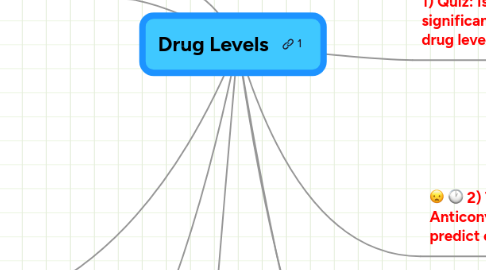
1. 4) Interpretation: Is this a toxic level or a therapeutic level?
1.1. What the drug does to the body
1.1.1. Agonist, antagonist, inverse agonist, did you think that's all?
1.1.1.1. ligand-biased efficacy
1.1.1.2. TDM may be most useful, when each patient serves as their own historical control to determine an individualized, safe and effective range of drug levels, rather than trusting a historical average from a different population, measured with a differently biased method (therapeutic interval).
1.2. Personalized medicine without genomics: Personal therapeutic intervals
1.3. What is a therapeutic range?
1.3.1. Therapeutic ranges are determined like reference intervals of other lab measurements such as glucose or sodium levels by clinical studies in certain populations. Unfortunately, as with endogenous chemicals in health and disease (sodium, by the way, is not endogenous, but dietary), therapeutic intervals always overlap with toxic ranges. What are health and therapeutic effects? Who decides what disease and toxicity are? How do these things vary, between different drug effects, from person to person, in the same person over time, depending on the environent?
1.4. What the body does to the drug
2. 5) How to calculate the next dose?
3. 6) What is the future of therapeutic drug management?
3.1. pharmacodynamic monitoring
3.2. phenotyping
3.3. metabolomics
3.4. genotyping
3.5. drive-by-whole-genome-scanning
3.6. omics and multivariate biomarkers
4. this and that
4.1. lab tests for poisoned patients
5. Take home message: Ask yourself: Will I do anything differently after the test result? If the answer is no, rethink whether the test is necessary.
6. Quality control: How good should a test be?
6.1. Precision goals based on upper and lower limits of the dosing interval (Glick, Burnett)
6.2. Precision goals based on dosing interval and elimination half-life (Fraser). Does Fraser, who demands biological variation as a basis for analytical precision goals, eliminate biological variation from his formula by using average half-lives? Should biological variation in TDM be interpreted as the change in drug level over time, or as random variation, e.g. in repeated trough levels in a stable patient?
6.3. RCV
6.4. Accuracy: How true is the truth?
7. 1) Quiz: Is this a significant change in drug level?
7.1. TCA steady state trough levels
7.2. Reference change values in therapeutic drug monitoring, an opportunity for research
7.3. Can the lab detect the smallest achievable change in drug level?
8. 2) TDM history: Anticonvulsant levels predict efficacy
8.1. ...or do they?
8.1.1. test
8.2. Therapeutic drug monitoring (TDM) and other reasons to measure drug levels
8.2.1. toxicity
8.2.2. absorbed
8.2.3. metabolism
8.2.4. drug interactions
8.2.5. protein binding
8.3. TDM/toxicology tests in Hamilton
9. 3) TDM is difficult
9.1. Chromatography and sample preparation
9.1.1. Analogies in Physiology?
9.1.2. HPLC
9.1.3. GC
9.2. Ion selective electrodes
9.2.1. Analogies in Physiology?
9.3. Immunoassay
9.4. Other challenges:
9.4.1. interferences, false positives, negatives
9.4.2. preanalytical errors
9.4.2.1. often overlooked, but critical in TDM: Sampling time
9.4.3. postanalytical errors
